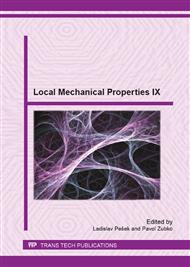p.3
p.11
p.15
p.19
p.23
p.27
p.31
p.35
Reduction of Elastic Modulus of Titanium Alloy Ti-6Al-4V by Quenching
Abstract:
The use of nanoindentation techniques enhances the capabilities of qualitative analysis of elasto-plastic characteristics, especially, estimating mechanical properties of relatively small specimens in their surface layers. The results are in agreement with macromethods, which gather the information over the higher volume of the material. It was confirmed, that hardening of double phase Ti-6Al-4V alloy by quenching from beta temperatures (above beta-transus), reduces the elastic modulus by about 8 % due to increased ratio of low-modulus beta phase from 8 to 34 %.
Info:
Periodical:
Pages:
15-18
Citation:
Online since:
September 2013
Authors:
Keywords:
Price:
Сopyright:
© 2014 Trans Tech Publications Ltd. All Rights Reserved
Share:
Citation:


